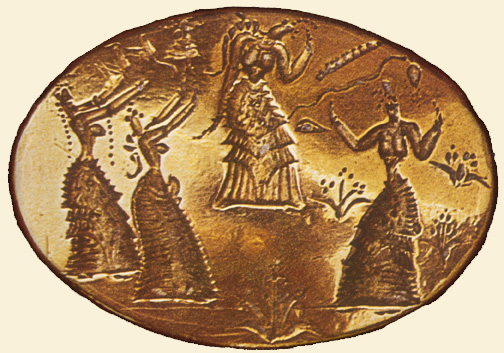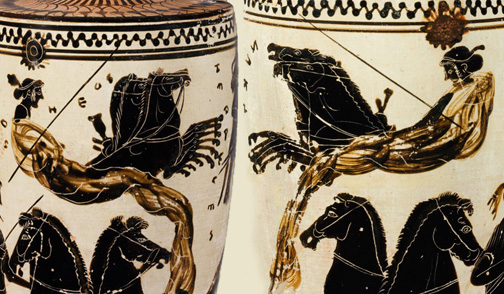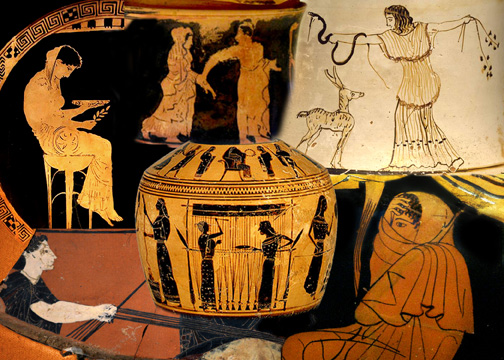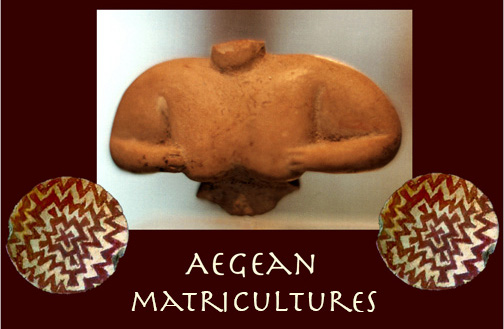Greece: Choose from five full-length
Live visual presentations by Max Dashu
Aegean Matricultures
Neolithic female figurines in Greek caves; Thessalian sites, Sesklo culture, interpretation and cross-Mediterranean comparisons. Female pairs, painted bowls, abstract female icons from Aigina and Sparta. The crosslegged figurines of neolithic Greece and Crete. Cycladic stone women, from the neolithic to the bronze age: mask faces, stylistic variations, “violin” shaped icons. Early Cycladic votive platters with spirals, suns, and vulvas.
Women and ceremony in Crete

Early female icons of the neolithic. Breastpots and painted ceramics. Early classic Cretan ceramic figures, dancers, the snake women and trance-eyes. Gold signet rings: women in ceremony, with trees, rocks and animal spirits; as shapeshifters, and other spiritual themes Cretan frescos: ceremony, dance, bull-leapers; and at Thera-Santorini, regattas and saffron-gathering for a goddess. Horned Lady of the Griffins, griffin thrones and chariots. The sacred knot, double axes, Mountain goddess, and matriarchal men. Pasiphae and Ariadne. Late Cretan shrines. Bell-figurines, snakes, birds, poppies, horns of consecration. Snake tubes / offering stands. The priestess motherline at Eleuthera and its golden artifacts, and more snake dancers. Cretan goddesses in the Greek Archaic and classical.
Mycenaean /Archaic Hellenes (1400-600)

Cretan influences: Linear B tablets, frescos, goldwork, seals, sphinxes and female pairs. Goddess and griffins. Geometric/Archaic painted amphorae, snakes, wheel-quadrants, and Lady of the Wolves and Geese. The women's dance, with greenery, or snakes. The Libyan Connection and the Danaids. Female mourners and the larnaxes. Phoenician influences in the late Archaic. Ivories of the Spartan goddess Ortheia. Potnia Theron: Lady of the Beasts. Athena of the Snakes, Gorgons and Medusa. Titanides: Tethys, Thetis, Mnemosyne, Rhea, Themis, Mousai.
Theai: Classical Greek Goddesses

Clay figures of the early Classic period, enthroned or in plank form; Nyx, Eos, Selene and other charioteers of the heavens; Athena of the Snakes, and how she was reshaped into a goddess of patriarchy; Artemis as Lady of the Beasts, huntress, and deer charioteer. The pillar goddess, with her garlands, polos headdress, and poppies: Hera Samion, Upis/Artemis Ephesia, Aphrodite of Aphrodisias, Atargatis. Hera in Greece and on Samos. Demeter and Persephone, the Sacred House of Eleusis, Baubo, and the Mysteries. Deep roots of Hekate; Aphrodite, Hygeia, the Moirae, and Medusa. Mythic conquests: Apollo vs. the dragon, Telphousa and Daphne. Gods who rape (the heroes too) and other patriarchalizing myths. Shown: Nyx and Eos.
Greek Women: Patriarchy and Priestesses

Sexual politics of the Iliad: virgin sacrifice, rape, and sex slavery. Iphigenia, Clytemnestra, Cassandra, and the Oresteia. Marriage, the sexual double standard, and female infanticide. Women's work and livelihoods. The veil, brothel slavery, and the hetairai. Atalanta the indominable huntress; the pervasive theme of the Amazons and the freedom of "barbarian" women: Lamia queen of Libya and Omphale queen of Lydia; Medea, Circe, Medusa. Women's ceremony and priestesses. The pythias of Delphi; dancers, drummers, maenads; rapist satyrs, Dionysos and gender politics.
Live visual presentation 90 minutes, with extra time for discussion
and questions; (available in shorter 60-minute version).
Requires digital projector, screen, and mic.
Suppressed Histories Archives | Articles | Max Dashu
